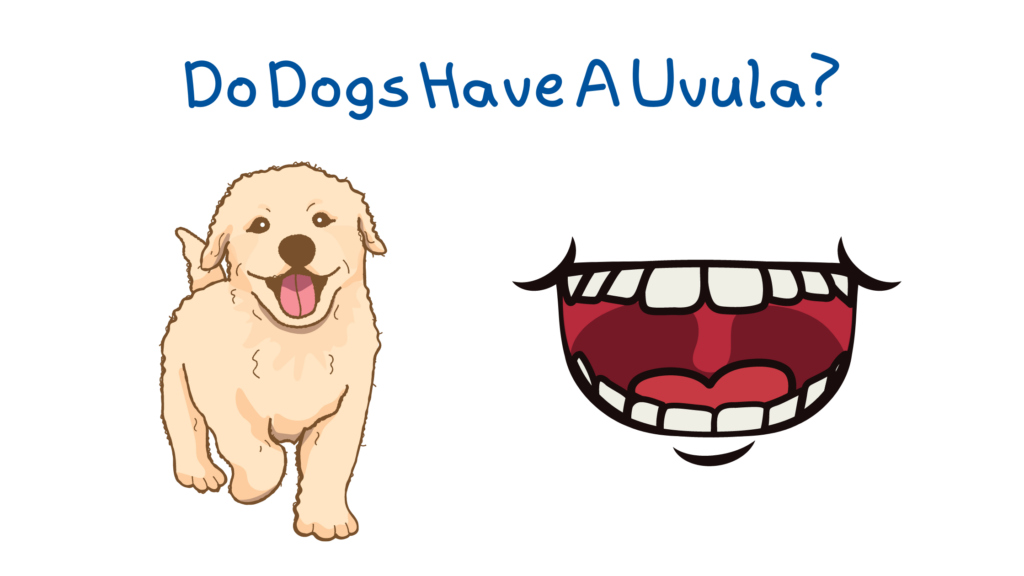Have you ever wondered what the inside of a dog’s throat looks like and whether it has the same parts as a human throat? One particular part you might be curious about is the uvula, that small, cone-shaped tissue you can see dangling in the back of your own mouth when you yawn or open wide. Known for its role in speech and swallowing in humans, it’s quite interesting to explore whether our dogs have uvulas too.
If you’re wondering do dogs have a uvula, the answer is no. Dogs don’t need an uvula to help them swallow or breathe because they keep their nasal passages closed when eating.

What Is A Uvula?
Imagine you’re standing inside your mouth, looking at the back of your throat. Right in the middle, at the top, there’s a little hanging thing that looks like a tiny punching bag. That’s called the uvula!
The uvula is a small, soft piece of tissue that hangs down from the middle of the back of your throat. It’s shaped like a small grape or a little piece of jelly. It’s usually pink in color and feels a bit squishy.
The uvula has a special job. When you talk or swallow, it moves around and helps to do a few important things. One of its main jobs is to help keep the food or drinks you swallow from going up into your nose. It acts like a little gatekeeper, making sure everything goes into your stomach instead.
Sometimes, you might notice your uvula moving when you say certain sounds or make funny noises. It’s a part of your body that helps you speak clearly, too!
Why Don’t Dogs Have A Uvula?
While dogs and humans have similar structures in their throats and mouths, a dog doesn’t have an uvula. This is because dogs have different swallowing and breathing mechanisms than we do. Dogs don’t need an uvula to help them swallow or breathe because they naturally keep their nasal passages closed off during these processes, thanks to their anatomical design. When a dog swallows, its larynx, or voice box, moves upwards, closing off the connection to the nasal passages. This prevents food or water from going into its nose, thus eliminating the need for an uvula. Dogs also don’t need an uvula to make sounds, as their vocal abilities are different from ours. They can bark, howl, and make other noises without it. Therefore, Mother Nature did not provide dogs with an uvula.
What Do Dogs Have Instead of a Uvula?
Dogs have a different structure in the back of their throat called the soft palate. The soft palate is a flexible, muscular structure that separates the back of the mouth (oral cavity) from the nasal cavity. It helps prevent food and liquid from entering the nasal passages during swallowing.
While dogs do not have a uvula specifically, the soft palate in dogs performs a similar function of directing food and liquids down the throat and preventing them from going into the nose. It assists in swallowing and protects the airway.
How Dogs Communicate Without A Uvula
Dogs do not have a uvula, but they have other anatomical structures that contribute to their vocalizations and communication.
Vocal Cords
Dogs, like humans, have vocal cords located in their larynx (voice box). The vocal cords are folds of tissue that can be tightened or relaxed to control the airflow through the throat. By adjusting the tension and position of their vocal cords, dogs can produce a range of sounds, including barks, growls, whines, and howls.
Mouth and Tongue
Dogs use their mouth and tongue to shape and modulate sounds. They can control the positioning and movement of their tongue to alter the resonance and tone of their vocalizations. Dogs may adjust the shape of their mouth, including the opening of their lips and the position of their teeth, to produce different sounds and convey specific messages.
Nasal Passages
Dogs utilize their nasal passages to add resonance and depth to their vocalizations. By directing air through the nasal passages while vocalizing, dogs can create different timbres and intensify the projection of their sounds. The nasal cavities play a role in enriching the quality and nuances of their vocal communications.
Facial Muscles
Dogs have a complex array of facial muscles that they can use to convey emotions and intentions. These muscles, including those around the eyes, ears, and mouth, contribute to their facial expressions, which are essential components of their non-verbal communication. Dogs can raise or lower their eyebrows, move their ears, and alter their mouth shape to communicate various emotional states.
While dogs lack a uvula, their ability to communicate and vocalize effectively is due to the coordination and control of these other anatomical structures. The vocal cords, mouth, tongue, nasal passages, and facial muscles work together to produce a wide range of vocalizations and non-verbal signals that allow dogs to express themselves and interact with humans and other animals.
Final Thoughts
Having delved into the intricacies of a dog’s throat, we have discovered the distinctive characteristics that set it apart from our own. It’s fascinating that, even though dogs don’t technically have a uvula as humans do, their bodies have adapted different ways of fulfilling their survival needs like swallowing and breathing. So, the next time you look into your dog’s mouth, you may not see a uvula hanging there, but you can appreciate the uniqueness of their anatomy and how efficiently it supports their communication and function.


